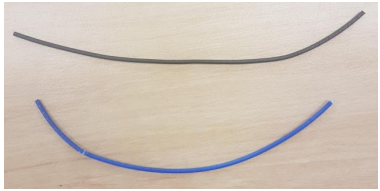In a paper entitled “Determining the Effect of Yield Strength of Acrylonitrile Butadiene Styrene through the inclusion of Chopped Carbon Fibre,” author Owen M. Cannings of the University of New South Wales at the Australian Defence Force Academy discusses potentially increasing the yield strength of 3D printed ABS parts by adding chopped carbon fiber. While carbon fiber is a common form of reinforcement in 3D printing materials, it usually comes in the form of continuous fibers throughout the material. The author aims to find out if chopped bits of carbon fiber can have the same effect.
First Cannings tested samples of plain ABS and ABS reinforced with chopped carbon fiber. The carbon fiber-reinforced sample experienced more deformation than the regular ABS sample, which suggests that the CF-ABS material is more ductile. He also tested the yield stress of 3D printed samples of both materials. The yield strength of the 3D printed parts was lower than that of the unprocessed filament, suggesting that the printed parts may have some voids or defects within them.
“Although the stress levels similar to the filament is ideal, the reduction in strength of the CF-ABS parts is still observed,” Cannings states. “For the 0-90 orientation, an average reduction in strength of 21.1% is observed. For the ±45° orientation samples, an average reduction in strength of 12.9% is observed.”
Cannings attempted to contact the company responsible for the manufacture of the filament, but received no response.
“From previous work with the product, it is advised the CF particles have an approximate aspect ratio of 1, meaning they exhibit no overall benefit in any one direction,” he continues. “This means that the testing modes of failure are currently unbeneficial, as the low aspect ratio means the fibres do not exhibit an increase in tensile strength in any direction. From this, the potential to increase the YS of ABS relies on the bond strength between the ABS and CF to be higher than ABS to ABS. the author is unable to find any research being conducted in this field. Other matrixes such as epoxy resin, utilising chopped particles exhibit lower bond strength between CF particles and the matrix whilst at high viscosities. As ABS has a high viscosity, the company responsible for manufacture may not have considered using a proper mixing procedure for the ABS within the chopped CF.”
This could be a major factor that affects the difference in strength between the ABS and carbon fiber-reinforced ABS samples. Future work, the author suggests, should focus on a proper mixing procedure and modification of the carbon fiber geometry. It is rather surprising that the parts 3D printed from plain ABS achieved higher yield strength values when compared to those 3D printed from carbon fiber-reinforced ABS. The inclusion of chopped carbon fiber particles within the ABS resulted in a reduction of between 13 and 29 percent tensile strength. More research needs to be conducted to determine the reason for this, but an initial estimate suggests that the bonding between the carbon fiber particles and the ABS plastic results in a weaker material.
Many operators buy CF filament in the hope that it outperforms regular filament. For many cases, we already know that the increased costs are not worth it at all for most users in most applications. Most carbon fiber filament is nonfunctional and silly. This is a useful piece of research that backs this up. We’re also grateful that amidst an endless stream of positive research results it is nice to have a negative result as well!
Discuss this and other 3D printing topics at 3DPrintBoard.com or share your thoughts below.
Subscribe to Our Email Newsletter
Stay up-to-date on all the latest news from the 3D printing industry and receive information and offers from third party vendors.
Print Services
Upload your 3D Models and get them printed quickly and efficiently.
You May Also Like
Making 3D Printing Personal: How Faraz Faruqi Is Rethinking Digital Design at MIT CSAIL
What if your 3D printer could think more like an intelligent assistant, able to reason through a design idea, ask questions, and deliver something that works exactly the way the...
Reinventing Reindustrialization: Why NAVWAR Project Manager Spencer Koroly Invented a Made-in-America 3D Printer
It has become virtually impossible to regularly follow additive manufacturing (AM) industry news and not stumble across the term “defense industrial base” (DIB), a concept encompassing all the many diverse...
Heating Up: 3D Systems’ Scott Green Discusses 3D Printing’s Potential in the Data Center Industry
The relentless rise of NVIDIA, the steadily increasing pledges of major private and public investments in national infrastructure projects around the world, and the general cultural obsession with AI have...
Formlabs Teams Up with DMG MORI in Japan
In late June, Nick Graham, Chief Revenue Officer at Formlabs, announced on LinkedIn that the company had partnered with DMG MORI, one of the world’s leading machine tool companies, to...




































